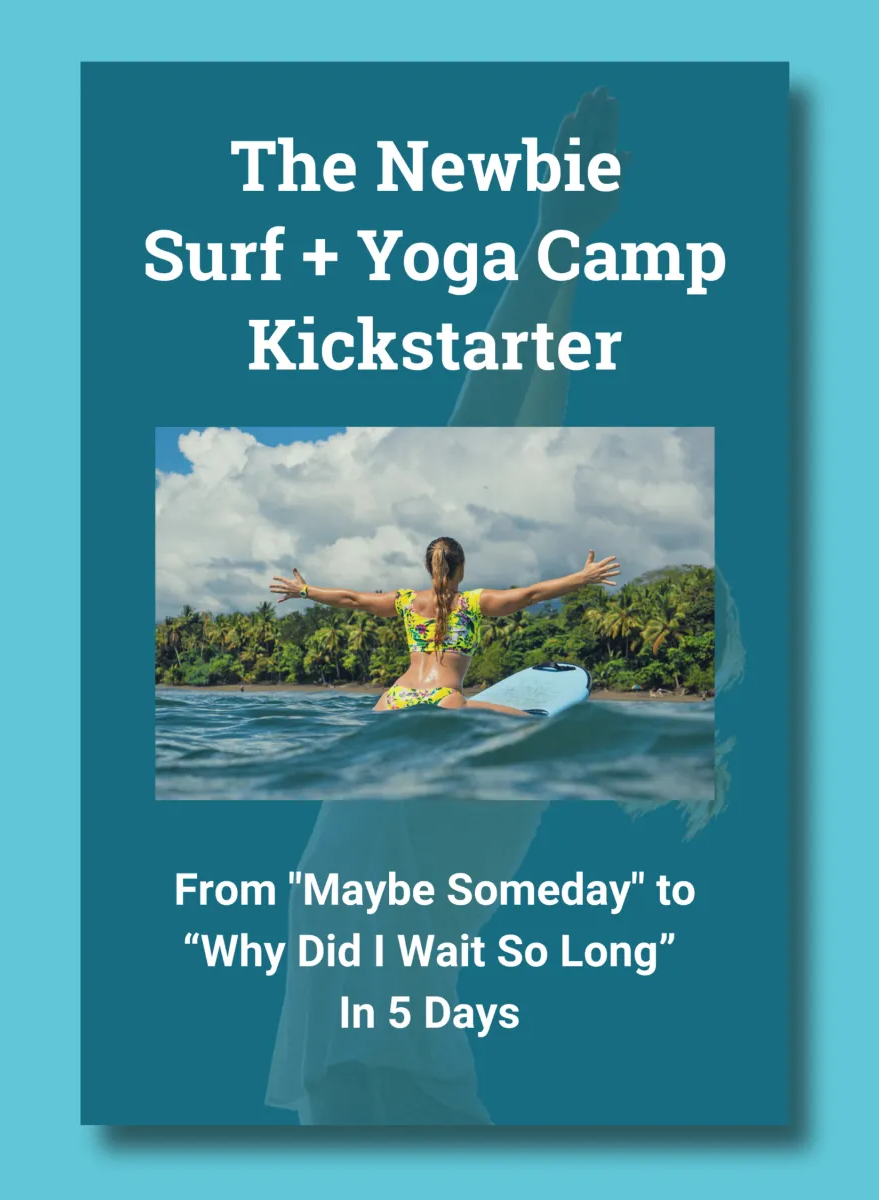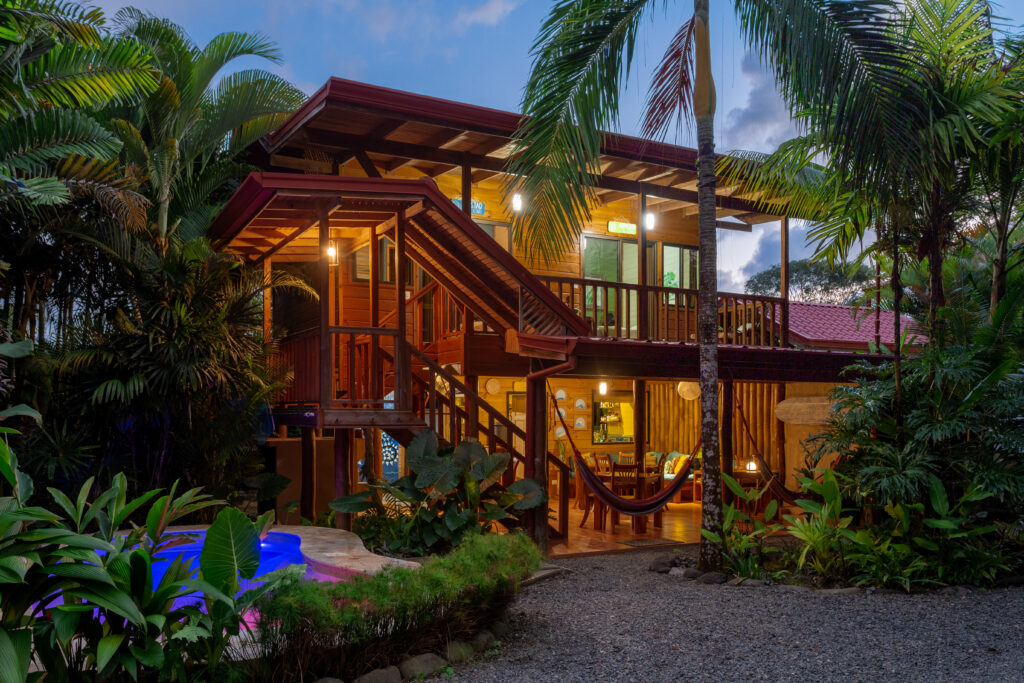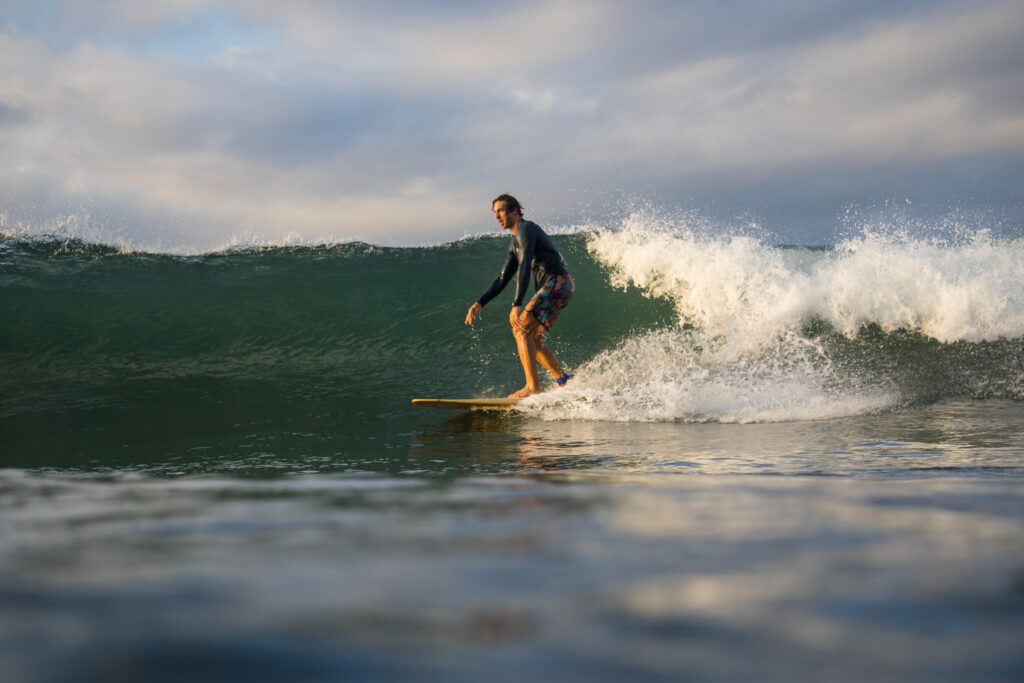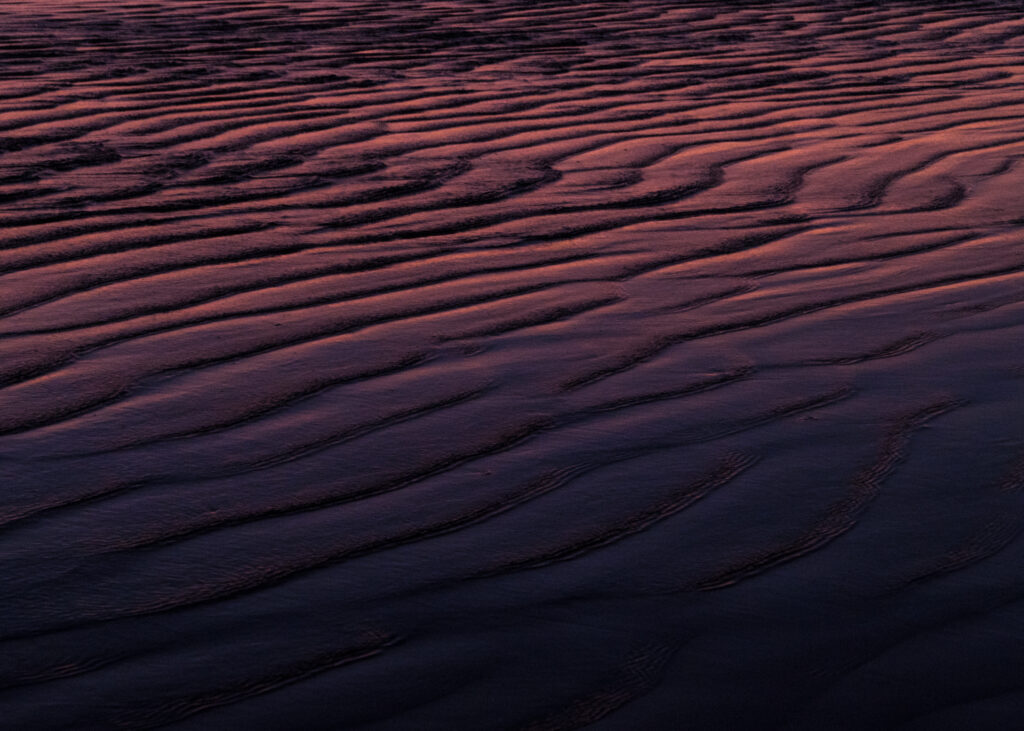How to Pop Up on a Surfboard: Learning to Surf in the White Water
This is the second installment in our larger Learn to Surf series, which breaks down our entire beginner surf curriculum with video and written lessons.
This post contains lessons two and three of seven. When you’re ready, continue with Lesson 5: How to Turn on a Surfboard.
If you are a beginner surfer attempting to pop up in the white water for the first time, or even an intermediate surfer struggling with your pop-up, then this blog is for you.
We will cover the following topics in this blog:
- Why to practice your pop-up in the white water
- How to walk your board through the impact zone
- How to identify a good white water wave
- Surf stance: are you goofy or regular?
- How to stand up using the “figure four” technique
- How to stand up using the “pop-up” technique
- Learning the proper surf stance
- Speeding up, slowing down, and bringing your surfboard to a stop
- How to safely fall off your surfboard
Note that the pop-up and stance techniques covered in this blog are geared toward surfing in the white water.
We highly recommend practicing your pop-up on dry land first, then getting many repetitions in in the white water before surfing in the green wave zone.
You can avoid forming bad habits by first mastering the surfing pop-up on the beach. Moreover, you can continue forming muscle memory by working on your pop ups on a yoga mat at home. Do this 20 times a day for a week and it will start to feel like second nature!
Finally, if you are surfing in the white water, then you should be walking your board out rather than paddling. This will conserve your energy and allow you to get more waves and more repetitions in before getting tired.
Also, if you’d like a primer on the different types of surfboards and what we recommend for beginners, start with this post here: The Different Types of Surfboard Shapes Explained.

7 Day Surf Camp
Week long, set-date, surf vacations that invite you to learn the art of surfing while learning about Mother Ocean, engaging with the community, and awakening the inner surfer.
Learn MoreWhy You Should Practice Popping Up in the White Water First
Surfing is unlike most other sports in that you depend on an ever-changing playing field — the ocean — to produce waves for riding.
To become a proficient surfer, you must first build muscle memory in a somewhat controlled environment (the white water zone) before paddling out to catch your first unbroken waves. The more white water waves you catch, the faster you will progress.
One of the common mistakes that beginner surfers make is trying to paddle all the way out to the green wave zone to catch their first waves.
Most of the time, these beginners tire themselves out in the process of paddling and are too exhausted to stand up once they make it to the wave zone.
It is also very challenging to read green waves and catch them if you haven’t been surfing in the white water first.
Therefore, the white water zone is the only place to simulate a controlled environment and accumulate consistent repetitions standing up to your feet.
If you are looking to conserve your energy so you can catch a bunch of waves and build muscle memory, then practicing your pop-up in the white water zone is the best place to start.
Walking Your Surfboard Out Through the Impact Zone
Here at Bodhi Surf + Yoga, we always instruct our students to walk their boards out rather than paddling out.
There are several reasons for this, but primarily we want you to conserve your energy so you can focus on how to catch waves and ride them without burning out too quickly.
- Once you have attached the surf leash to your ankle, walk your board out to knee-deep water before setting it down flat on the surface.
- If you are right-handed, set the board down on your right side with the nose of the board pointed directly into the oncoming walls of white water. Put the board down on your left side if you are left-handed.
- As you walk your board out to deeper water, place both hands on the back of the board so you can put pressure on the tail and lift up the nose to go over oncoming waves.
- Do not back away from the waves as they approach. Keep your momentum moving forward and hit the wave with the surfboard before it hits you. Maintain a firm grip on the back of the board so the waves don’t rip the board out of your hands.
- Spear technique: with your hands firmly placed over the surfboard’s tail, take a step forward at the oncoming wall of white water and push or “spear” the nose of the board through the approaching wave.

How to Identify a Good White Water Wave for Surfing
Once you have made it out to stomach-deep water, you are ready to look for a rideable white water wave to catch.
This is one of the hardest things to learn as a beginner surfer: what does a good white water wave look like?
- Look for a bigger wave that has already broken far away from you. The trick is to identify the wave early so you have plenty of time to turn your board around and hop on.
- A more powerful wave will lend extra stability — important for maintaining balance during the pop up process.
- The wave should look like a “wall” or “ledge” of white water coming in straight across the surface of the ocean.
- Try to avoid any wave that is breaking close to you (or right on top of you), as it will probably knock you off your board or cause you to nose dive.
Once you identify your wave, it is time to turn your board around, hop on, and start paddling for the wave.
For more information about positioning yourself on the board and catching the wave, refer to our previous post in the Learn to Surf series: Surfboard Control for Beginners.
Goofy or Regular: Which Surf Stance are You?
The first thing you need to figure out before popping up to your feet on a surfboard is which way you will be facing.
In other words, do you prefer to stand with your left foot in front and your right foot in back (regular footed), or with your right foot in front and your left foot in back (goofy footed)?
If you have previous board-riding experience, such as skateboarding or snowboarding, it should be easy to figure out whether you are regular or goofy.
But if you’ve never popped up on a board before, then it may be difficult to determine which stance will work best for you.
Practice popping up to your surf stance in both directions (regular and goofy) several times on dry land to see which direction your body naturally prefers.

How to Stand up Using the “Figure Four” Technique
If you’ve never stood up on a surfboard before, then the “figure four” technique is a good place to start.
The figure four is our “training wheels” version of the pop-up, as it happens in controlled stages rather than all at once.
Basically, the goal is to step your back foot forward (into position first) and then your front foot. The goal is to get your feet onto the board without using your knees (which is considered a bad habit).
- Once you catch the white water wave and feel the wave push you, place your hands flat on the deck of the board in cobra position (hands in line with your rib cage).
- As you begin to lock out your arms and lift up your chest, take your back foot and tuck it up under your butt by bringing your knee outside the rail of the board.
- If you are a regular footer, you will bend your right knee and tuck your right foot up under your butt. If you are a goofy footer, you will bend your left knee and tuck your left foot under your butt.
- Once you have your back foot in position, you will then lock out your arms completely and step your front foot forward, up between your hands (into the front half of the board).
- Finally, you can lift your hands up off the deck of the board and shift your weight into your legs as you stand to your feet.
- Rather than looking down at your feet, try to keep your eyes on the horizon as you stand up. This will keep your head still and make it easier to balance.
The most important thing to remember when learning how to pop up is to take your time! Don’t be in a rush to pop up. If you are in a hurry, then you will probably fall.

How to Stand Up Using the Pop-up Technique
The pop-up technique is a bit more advanced than the figure four because it requires more speed and athleticism.
The key difference between the pop-up and the figure four is that you are sliding both feet up under you at the same time, rather than stepping each foot up individually.
- Once you feel the white water wave push you, place your hands as low as possible on the deck, in line with the ribcage, and begin to press up (this will also prevent you from nose-diving).
- Keep in mind that an efficient pop-up is built on leverage and momentum, not upper body strength. The more space you can create under your midsection, the easier it is to bring your feet up under you.
- Keep your eyes forward, lock out your arms completely, and start to lift your core and hips up into plank position plank position to create space under you. Next, get some forward momentum and slide your feet forward and under your body.
- Make sure to keep your feet as close to the board deck as possible. Think about sliding your feet under your midsection in a single fluid motion rather than jumping up and landing off-balance.
Remember not to be in a hurry to pop up. The first few you do can even be in slow motion. Ensure you have caught the wave first and secured the takeoff before popping up to your feet.
Again, try to keep your eyes on the horizon and stay as low as possible when sliding up to your feet. This will ensure that you stay balanced and in control of the board.
Mastering The Proper Surf Stance (for Beginners)
When doing a pop-up from the prone position to standing, it is critical to place your feet in the correct position on the surfboard.
Proper foot placement
- Your back foot should land just in front of the fins and your front foot should land in the front half of the board (just past the midway point). A good stance stance is slightly wider than shoulder-width.
- Your surfboard has a thin strip of wood that runs down the center line of the board from nose to tail called the stringer. Both of your feet should be centered directly over the stringer so that the stringer splits each foot in half from heel to toe.
- The toes of your back foot should point directly at your toe-side rail so that your foot creates a 90-degree angle with the rail. The toes of your front foot can open slightly toward the nose creating a 45-degree angle with the rail.
Lower body placement
- Once you get your feet into position, keep your knees bent and stay low in your lower body. Your ankles, hips, and shoulders should all form a plane
- Most beginners will lock out their legs and stand straight up as soon as they get to their feet, which causes them to lose their balance and fall.
- Furthermore, many beginner surfers will either hold their arms in a straight line (think Warrior II) or place both hands over their toe-side rail. This is incorrect and may force you to lose your balance.
What to do with your upper body
- Make sure to maintain good posture in your upper body; do not lean or slouch over. Your shoulders, knees, and toes should all be in the same vertical plane.
- For proper hand positioning, imagine a tight-rope walker with arms extended over each side of the line. Your hands should be positioned over the rails, with both hands pointing forward in the direction of travel.
- Your lead arm should be extended, and your back arm bent at 90 degrees. Keep your head and shoulders pointed in the direction you want to go.
Lastly, wherever you look is where you will go. If you are looking down at your feet or at the nose of the board (a very common mistake), you will probably fall.

How to Speed Up, Slow Down, and Bring Your Surfboard to a Stop
After you pop up to your feet and riding straight to the beach, your next step is to work on managing your speed and bringing the board to a controlled stop.
This will allow you to gain awareness of your surroundings and avoid collisions with other surfers and swimmers.
Speeding up your surfboard
- To maintain speed or even go a bit faster on the surfboard, sink into your legs and shift your hips forward so most of your weight is now on your front foot. You can even reach your lead arm out in front of you to help guide your weight toward the nose of the board.
- Do not break the vertical plane in your upper body by leaning forward: bend your knees and transfer your weight into the front knee and foot.
Slowing down your surfboard
- To slow down, sink into your legs and shift your hips back so your weight is now on your back foot. You can retract your hands back away from the nose of the surfboard to help you guide your weight into the back leg.
- Once you’re comfortable shifting your weight from front foot to back foot, you could even try stepping back over the tail to slow down more efficiently. As a challenge, see if you can lift the nose of the surfboard up out of the water as you shift your weight back over the tail.
Stopping the surfboard
- In order to bring the board to a controlled stop, you must be able to shift all of your weight into the back half of the board where the “brakes” are. The more weight you have over the tail, the easier it will be to stop moving forward.
- The goal is to lift the nose of the board up out of the water by either stepping back over the tail, shifting your hips back, or coming down to your knees and pushing back into child’s pose.
We recommend trying all three stopping methods — the step back, the shift back, and the kneel down to child’s pose — to see which technique works best for you.
You always have the option to fall off the back of the board using a “backflop” technique, but it’s better to bring the board to a controlled stop so you can avoid colliding with someone (or something) in front of you.

How to Fall Safely Off Your Surfboard
Now that you are standing to your feet on the board, you will probably be falling (aka wiping out) frequently. Don’t worry, wiping out is a normal part of the learn-to-surf process, but you want to make sure you don’t get injured during this stage.
- If you feel like you are losing balance, it is best to fall off the back of the board, rather than jumping or diving off the side. When you fall off the back, the board will travel away from you so you don’t get hit, and you have a nice ledge of white water to fall on top of.
- Try to spread yourself out and fall flat on your belly (like a starfish) or back (like a back flop) so you break your fall and don’t hit the seafloor.
Remember to always cover your head and face when resurfacing from a wipeout to ensure you don’t get hit by the board.
Read the next series installment, How to Turn on a Surfboard.

For First-Time Surfers
You Don't Need Experience. You Don't Need Gear. You Just Need This.
Our free 5-day email course that reveals the 5 myths keeping beginners at "I'm not ready" instead of catching their first wave and finding inner peace-and how to overcome them fast.
Change the heading on the Separator tab ->
Search
The Newbie Surf + Yoga Camp Kickstarter
Bust the 5 biggest myths about going to a surf and yoga camp so you can stop procrastinating and start catching waves - with our FREE 5-day email course.
Change the heading on the Separator tab ->
Most Read Blogs
What is the Meaning of Anjali Mudra?
May 27, 2020
Fitness for Surfers: Workouts, Exercises & Training
February 10, 2022
The Best Places to Eat in Uvita, Costa Rica
May 19, 2022
How to Get From SJO to Costa Ballena, Costa Rica
May 31, 2018
Change the heading on the Separator tab ->
Categories
Categories
- Bodysurfing (5)
- Food (8)
- Responsible Business (6)
- Surfing (66)
- Travel (65)
- Yoga (44)
Change the heading on the Separator tab ->
Newsletter
Thanks for subscribing! Please check your email for further instructions.
Change the heading on the Separator tab ->
Follow Us
Bodhi Surf + Yoga
Change the heading on the Separator tab ->
Read more
5 Reasons Why a Surf + Yoga Retreat Should Be Your Next Big Bucket List Adventure
Words by Travis
If you’re reading this, chances are you’re experiencing a little restlessness. You’ve scrolled past the passive beach vacations and you know, deep down, that your next trip needs to be different. It…
Small Things That Make A Big Difference to Progressing Your Surfing
Words by Guest Post
Welcome to the first of our three-part series covering the small things that make a big difference to your surfing! You are most likely reading this because you’ve taken some surf lessons…
Sandbars for Surfers: Everything You Need to Know and More
Words by Guest Post
Ever wonder what a sandbar is? When it’s low tide you can see them, but what happens when the ocean covers them? Most surfers may just look at the waves on the…



